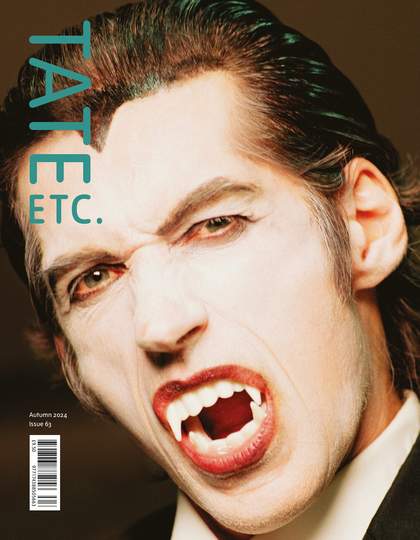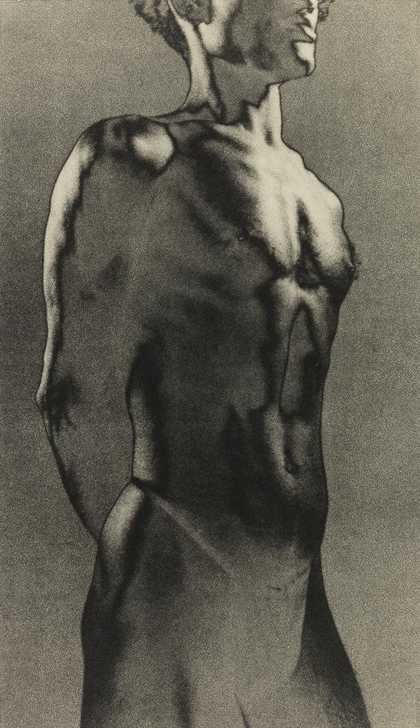A strange pall has fallen over the Tate Etc. offices in recent weeks. As the days shorten and shadows lengthen, we have become increasingly disturbed by unexplained noises, flashing lights and a regular procession of what can only be described as apparitions, monsters and ghosts. Some might attribute this startling change to overactive imaginations, an excess of caffeine and the curious river and sea mists that occasionally shroud Tate’s four galleries. Others might point instead to Tate’s autumn programme: a phantasmagorical array of artistic activities that wear thin the barrier between daily life and more thrilling realities.
Our cover star is a character from the forthcoming Mike Kelley exhibition at Tate Modern: Ghost and Spirit. The first major retrospective of the legendary American artist in the UK showcases the mischievous and often melancholy spirit that animated his work from the late 1970s to the 2010s. ‘Horror’, as writer Charlie Fox says, ‘is the genre where we go to find out what’s really going on inside: all our gore and trauma and hideousness festively unleashed’.
Hauntings of one kind or another can be found on almost every page. Lucy Ives confronts the ever-growing hoard of data that follows us like a shadow in her essay on Electric Dreams, a mesmerising exhibition coming to Tate Modern this autumn. Elsewhere, we step behind the scenes to see Mire Lee’s visceral sculptures being made for her Hyundai Commission in Tate Modern’s Turbine Hall; the artist Allison Katz recreates a disconcertingly familiar childhood photograph; and Richard Wilson’s famous work Cader Idris reflects a particularly terrifying Halloween visitation.
Read on, if you dare,
Tate Etc.

Contents
Mutant Mike
The playful and subversive spirit of Mike Kelley's 'wildly mutating oeuvre' continues to haunt contemporary art, writes Charlie Fox
Agony Artist: Dear Pipi
Introducing our next agony artist Pipilotti Rist, who brings her zany approach to creativity to her new advice column. If …
In Nature’s Thrall
Anne Brigman’s unbridled portraits, taken in the high-altitude Sierra Nevada, capture the ‘dissolution of identity’ one feels in a vast, …
Kindred Spirits
Allison Katz recalls the uncanny experience of encountering her childhood selves while working on a recent painting
'It has to be sloppy'
As Mire Lee works on her new commission for Tate Modern’s Turbine Hall, artist and writer Ami Lien talks to …
Turner Prize 2024
Photography by Suzannah Pettigrew
Red Matter
Amber Husain unpacks the manifestations of power that turn flesh into meat
Magic Mountain
Mike Parker remembers one terrifying Halloween spent alone on the summit of Cader Idris
Deep in the Stone
Damian Le Bas Jr speaks to his friend, the Romani artist Małgorzata Mirga-Tas, about reclaiming history, reshaping stories and …
The Simoom
Luna Carmoon gets swept up in JMW Turner’s small watercolour depicting a violent desert storm
Are We Dreaming?
The bewildering proliferation of new technologies in the postwar era presented artists with unique opportunities for creative expression. But how …
Level Up
When Suzanne Treister bought her first computer in the early 1990s, her art entered a new dimension
Cansu Çakar
Fresh from her St Ives residency, the artist talks to us about Cornish legends, sea snails and the secret messages …
My Own Muse
Penny Slinger looks back at the origins of her feminist approach to surrealism, the seeds of which were sown at …
Friendly Fire
'What on earth is fun about it?' The weekend wargames captured by photographer Anna Fox vividly reflect the competitive culture …
Walking Backwards
Jasia Reichardt takes us on an exclusive step-by-step tour of a new Tate Britain display celebrating the unconventional work of …
Taste Etc: Steph Huang
Fold Your Hands with Chilli Oil
Turning Points
Curator Beatriz Cifuentes Feliciano speaks to Nepali artist Shashi Bikram Shah in his studio in Lalitpur about his extraordinary 60-year …
Ship to Shore: By Ruby Tandoh
Steph Huang’s new Art Now commission is an invitation to pay close attention to the offshore food industry. Photography by …


